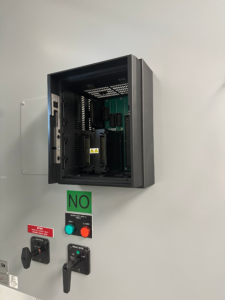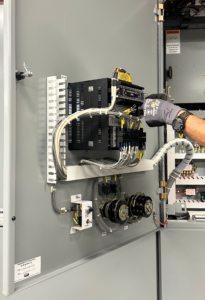
 As data center construction ramped up in the 1990s and the size of facilities grew, electrical distribution transitioned from low voltage (480 volt) to medium voltage (12-14kV). These design changes brought about the need for more sophisticated electrical distribution protection, which coincided with the early generations of electronic protective relays, including the widely used GE MultiLin relays. As with all electrical equipment, relays have a life expectancy. The majority of 1990s and early 2000s installed relays have reached their end-of-life, with manufacturers announcing there will no longer be any product support; this means no new relays, no updated software, and no repair parts from the manufacturers. Data center owners and operators have a unique opportunity to not only replace existing relays but also reevaluate needs and functionality and take advantage of enhanced performance with current model relays.
As data center construction ramped up in the 1990s and the size of facilities grew, electrical distribution transitioned from low voltage (480 volt) to medium voltage (12-14kV). These design changes brought about the need for more sophisticated electrical distribution protection, which coincided with the early generations of electronic protective relays, including the widely used GE MultiLin relays. As with all electrical equipment, relays have a life expectancy. The majority of 1990s and early 2000s installed relays have reached their end-of-life, with manufacturers announcing there will no longer be any product support; this means no new relays, no updated software, and no repair parts from the manufacturers. Data center owners and operators have a unique opportunity to not only replace existing relays but also reevaluate needs and functionality and take advantage of enhanced performance with current model relays.
Questions to Consider
1. Are your relays obsolete?
Equipment manufacturers send out notices in advance of planned obsolescence. Still, many factors can prevent this information from reaching the current owner, such as facilities changing hands, personnel changing positions or retiring, and relays installed in equipment provided by others (OEMs such as Russelectric or ASCO).
2. Have you considered your replacement options?
GE, for example, has conversion kits that would seem to make the replacement decision easy; however, there are options to consider. This is an opportunity to revisit your relays and decide precisely how you want them to perform. Earlier generation relays were limited in their capabilities; today’s relays offer more features and functionality. Were your original relays selected based on need or to make the engineer’s specifications easier? Often, the same relay was specified for all applications meaning some features were not needed. Working with a knowledgeable consultant, you can determine your current and future needs to take advantage of new features. You may decide to switch manufacturers based on needs, availability, functionality, and cost. Are you considering future plans for your facility when replacing relays and making sure the replacement relays will match or complement the new equipment and upgraded monitoring systems you may install?
3. Have you planned properly for the replacement installation?
Once you have determined which relays to purchase, you have several more steps to a successful replacement. Will you be able to reuse existing wiring or need to rewire? Your consultant will need to study the existing wiring diagrams to decide how the relays were intended to function and perform a site assessment to see how they are wired. Was the original relay programmed correctly? Does a new relay program need to be written to take advantage of new features or needs? GE has conversion software, but, like most upgrades, it may not convert all used features and, in our experience, requires review and relay testing for validation before installation. If you choose to change relay manufacturers, then conversion software does not exist, and a new program must be written.
4. Live Site Concerns
Relay retrofits should not be done on energized circuits because you are without protection during the upgrade, and in some cases, the installation cannot be done safely. Ideally, you can de-energize an entire switchgear lineup or at least each section or cubicle for the retrofit. Tier 3 or 4 sites will have an advantage over a Tier 1 or 2 site as their facility design allows for de-energization and isolation of switchgear. We recommend doing as much bench and field testing as possible prior to energization and live load. Other nuances throughout this process are often neglected, including the relays’ interactions with your site’s BMS and EPMS. These systems will also need to be checked and reprogrammed to maintain relay communication and functionality.
 What’s Next?
What’s Next?
There are multiple steps for safely replacing obsolete relays in your data center. You need the right relays with the correct features and programming, updated wiring diagrams and wiring, pretesting and performance validation, a carefully planned outage, and the relay programmer on-site during the changeout. Relays are your site’s electrical protection. Execute these replacements incorrectly, and you could create risk and end up with unplanned downtime or a circuit that is not properly protected, which may lead to equipment damage or personnel injury – not events any data center wants to create. Working with an experienced data center and relay protection consultant who can guide you through the complex relay replacement process is essential for a seamless upgrade.

